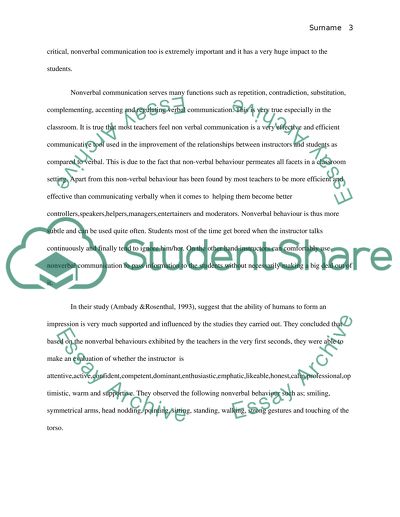![The Verbal and Non-Verbal Communication: [Essay Example], words GradesFixer](https://www.coursehero.com/thumb/dd/b8/ddb821e5ac399ce1a569236ab77ef5392667b95d_180.jpg)
Get professional help and free up your time for more important courses
· Different from verbal communication, non-verbal communication involves sending and receiving cues that are wordless. Firstly, non-verbal communication can involve vocal cues that are termed as paralinguistic. Paralinguistic include things such as tone, volume, inflection, pitch, and pronunciation · Verbal and Nonverbal Communication is very important to make us understood the different aspects of verbal and non-verbal communication, types of verbal and nonverbal communication, and the important roles they play in our interactions with others · Non verbal communication refers to communicating by actions and without using words. It includes facial expressions (anger, happy, sad), body language (shaking hands indicate nervousness, sitting in upright position show that you’re attentive) and appearance that shows how groom your personality is (dress, body Oder, etiquettes)
Significance of Nonverbal Communication
· Verbal communication is the use of sounds and words to express oneself. Nonverbal communication is the process of conveying the meaning without the use of either written or spoken. Verbal and nonverbal communication is different because one uses words to transmit the message to another person, while the other does not.4,7/5(13) · Interaction with people are constructed using verbal and nonverbal communication. Hence, they contribute to both physical and mental wellness of individuals. Amy Lucas (), has also emphasised that both verbal and nonverbal are essential in developing relationships and strengthening positive forms of communication · Different from verbal communication, non-verbal communication involves sending and receiving cues that are wordless. Firstly, non-verbal communication can involve vocal cues that are termed as paralinguistic. Paralinguistic include things such as tone, volume, inflection, pitch, and pronunciation

Find Free Essays
· Non verbal communication refers to communicating by actions and without using words. It includes facial expressions (anger, happy, sad), body language (shaking hands indicate nervousness, sitting in upright position show that you’re attentive) and appearance that shows how groom your personality is (dress, body Oder, etiquettes) · Different from verbal communication, non-verbal communication involves sending and receiving cues that are wordless. Firstly, non-verbal communication can involve vocal cues that are termed as paralinguistic. Paralinguistic include things such as tone, volume, inflection, pitch, and pronunciation · Interaction with people are constructed using verbal and nonverbal communication. Hence, they contribute to both physical and mental wellness of individuals. Amy Lucas (), has also emphasised that both verbal and nonverbal are essential in developing relationships and strengthening positive forms of communication

Features of Nonverbal Communication
· Different from verbal communication, non-verbal communication involves sending and receiving cues that are wordless. Firstly, non-verbal communication can involve vocal cues that are termed as paralinguistic. Paralinguistic include things such as tone, volume, inflection, pitch, and pronunciation Verbal communication is an act of conveying messages, ideas, or feelings through the use of mouth. Verbal communication is the main way of communicating face-to-face. Among the key components of the verbal communication are words, sound, speaking, and language. 9 effective forms of Verbal Communication 1 · Verbal and Nonverbal Communication is very important to make us understood the different aspects of verbal and non-verbal communication, types of verbal and nonverbal communication, and the important roles they play in our interactions with others
Communication occurs between two parties and is a two-way process
Verbal communication is an act of conveying messages, ideas, or feelings through the use of mouth. Verbal communication is the main way of communicating face-to-face. Among the key components of the verbal communication are words, sound, speaking, and language. 9 effective forms of Verbal Communication 1 · Interaction with people are constructed using verbal and nonverbal communication. Hence, they contribute to both physical and mental wellness of individuals. Amy Lucas (), has also emphasised that both verbal and nonverbal are essential in developing relationships and strengthening positive forms of communication · Verbal and Nonverbal Communication is very important to make us understood the different aspects of verbal and non-verbal communication, types of verbal and nonverbal communication, and the important roles they play in our interactions with others
No comments:
Post a Comment